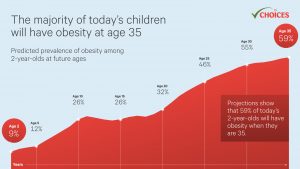A CHOICES study finds that the obesity epidemic is far from over and is likely to become much worse, as study results predict that 57% of today’s children will have obesity at age 35. Public health professionals need to re-double their efforts to prevent such an outcome. The CHOICES Project has identified cost-effective interventions in school and community settings that can prevent future obesity cases.
Ward Z, Long M, Resch S, Giles C, Cradock A, Gortmaker S. Simulation of Growth Trajectories of Childhood Obesity into Adulthood. N Engl J Med. 2017 Nov 30;377(22):2145-2153.
The current childhood obesity epidemic has been well-documented, but more research is needed on the long-term risks for children. For this study, the researchers developed an individual-level simulation model for the current population of children in the U.S. that estimates the risk of adult obesity at age 35 years. Height and weight data were gathered from 5 nationally-representative longitudinal studies. The model, representative of the U.S. population in 2016, created 1,000 virtual populations of 1 million children each. Using this model with these virtual populations, obesity risk trajectories were projected up to the age of 35 years.
The researchers predict that, if nothing is done to change current trends, 57% of today’s children will have obesity at age 35. This is a large increase, given that 37% of adults now have obesity. In addition, the study found that excess weight in childhood is highly predictive of adult obesity. This is especially true for children with severe obesity, even at very young ages. The team estimated that 79% of two year-olds with severe obesity will still have obesity by the time they are 35 years old, as will 94% of 19 year-olds with severe obesity. Racial and ethnic disparities in obesity are already present by the age of two and persist into adulthood.
The results of this study reinforce some important public health messages.
“We find that obesity will be a significant problem for most children in the U.S. as they grow older,” said Zachary Ward, lead author on the study. “Given their increased risk of adult obesity, it seems clear that children who already have obesity are prime candidates for early intervention. However, even children currently at a healthy weight can benefit from preventive interventions, given the high risk of developing obesity in young adulthood.”
The team also noted that the findings of this study highlight the importance of promoting a healthy weight throughout childhood and into adulthood.
Given the high risk posed to children – especially those who already have obesity – public health professionals need to work to identify and implement effective strategies that focus on preventive interventions for all children. In previous work, the CHOICES team has identified a number of cost-effective interventions that with broad population reach. Such interventions focus on preventing excess weight gain starting at an early age by providing opportunities for healthier foods, beverages, and physical activity, such as within early care and education and school settings. Some of these interventions are projected to save more in future health care costs than they cost to implement.
See our news story for the full list of media coverage of this article.
Forecasting Trends in Child Obesity with Zach Ward
Lead author Zach Ward discusses the paper with the Center for Health Decision Science.
Forecasting Trends in Child Obesity with Zach Ward from CHDS Media Hub on Vimeo.
